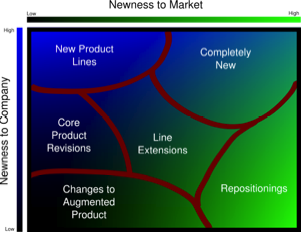 Our services
Our services
Amelioration & Design of Products / Services
• Improve your products and services
• Research and select new ideas, develop the product and do a feasibility study
• Establish a quality control system.
Product development explained
In business and engineering, new product development (NPD) is the term used to describe the complete process of bringing a new product or service to market. There are two parallel paths involved in the NPD process : one involves the idea generation, product design, and detail engineering ; the other involves market research and marketing analysis. Companies typically see new product development as the first stage in generating and commercializing new products within the overall strategic process of product life cycle management used to maintain or grow their market share.
Contents
1 Types of new products
2 The process
3 Fuzzy Front End
4 See also
5 Notes
6 References
7 External links
 Types of new products
Types of new products
There are several general categories of new products. Some are new to the market (ex. DVD players into the home movie market), some are new to the company (ex. Game consoles for Sony), some are completely novel and create totally new markets (ex. the airline industry). When viewed against a different criteria, some new product concepts are merely minor modifications of existing products while some are completely innovative to the company.
• Changes to Augmented Product
• Core product revision
• Line extensions
• New product lines
• Repositionings
• Completely new
The process
1. Idea Generation
(The "fuzzy front end" of the NPD process, see below)
• Ideas for new products can be obtained from customers (employing user innovation), designers, the company's R&D department, competitors, focus groups, employees, salespeople, corporate spies, trade shows, or through a policy of Open Innovation. Ethnographic discovery methods (searching for user patterns and habits) may also be used to get an insight into new product lines or product features. • Formal idea generation techniques can be used, such as attribute listing, forced relationships, brainstorming, morphological analysis and problem analysis
 2. Idea Screening
2. Idea Screening
•The object is to eliminate unsound concepts prior to devoting resources to them.
•The screeners must ask at least three questions:
o Will the customer in the target market benefit from the product?
o Is it technically feasible to manufacture the product?
o Will the product be profitable when manufactured and delivered to the customer at the target price?
3. Concept Development and Testing
•Develop the marketing and engineering details
o Who is the target market and who is the decision maker in the purchasing process?
o What product features must the product incorporate?
o What benefits will the product provide?
o How will consumers react to the product?
o How will the product be produced most cost effectively?
o Prove feasibility through virtual computer aided rendering, and rapid prototyping
o What will it cost to produce it?
•test the concept by asking a sample of prospective customers what they think of the idea. Usually via Choice Modelling.
4. Business Analysis
•Estimate likely selling price based upon competition and customer feedback
•Estimate sales volume based upon size of market
•Estimate profitability and breakeven point
5. Beta Testing and Market Testing
•Produce a physical prototype or mock-up
•Test the product (and its packaging) in typical usage situations
•Conduct focus group customer interviews or introduce at trade show
•Make adjustments where necessary
•Produce an initial run of the product and sell it in a test market area to determine customer acceptance
6. Technical Implementation
•New program initiation
•Resource estimation
•Requirement publication
•Engineering operations planning
•Department scheduling
•Supplier collaboration
•Logistics plan
•Resource plan publication
•Program review and monitoring
•Contingencies - what-if planning
7. Commercialization (often considered post-NPD)
•Launch the product
•Produce and place advertisements and other promotions
•Fill the distribution pipeline with product
•Critical path analysis is most useful at this stage
These steps may be iterated as needed. Some steps may be eliminated. To reduce the time that the NPD process takes, many companies are completing several steps at the same time (referred to as concurrent engineering or time to market). Most industry leaders see new product development as a proactive process where resources are allocated to identify market changes and seize upon new product opportunities before they occur (in contrast to a reactive strategy in which nothing is done until problems occur or the competitor introduces an innovation). Many industry leaders see new product development as an ongoing process (referred to as continuous development) in which the entire organization is always looking for opportunities.
For the more innovative products indicated on the diagram above, great amounts of uncertainty and change may exist, which makes it difficult or impossible to plan the complete project before starting it. In this case, a more flexible approach may be advisable.
 Because the NPD process typically requires both engineering and marketing expertise, cross-functional teams are a common way of organizing projects. The team is responsible for all aspects of the project, from initial idea generation to final commercialization, and they usually report to senior management (often to a vice president or Program Manager). In those industries where products are technically complex, development research is typically expensive, and product life cycles are relatively short, strategic alliances among several organizations helps to spread the costs, provide access to a wider skill set, and speeds the overall process.
Because the NPD process typically requires both engineering and marketing expertise, cross-functional teams are a common way of organizing projects. The team is responsible for all aspects of the project, from initial idea generation to final commercialization, and they usually report to senior management (often to a vice president or Program Manager). In those industries where products are technically complex, development research is typically expensive, and product life cycles are relatively short, strategic alliances among several organizations helps to spread the costs, provide access to a wider skill set, and speeds the overall process.
Also, notice that because engineering and marketing expertise are usually both critical to the process, choosing an appropriate blend of the two is important. Observe (for example, by looking at the See also or References sections below) that this article is slanted more toward the marketing side. For more of an engineering slant, see the Ulrich and Eppinger reference below.
People respond to new products in different ways. The adoption of a new technology can be analyzed using a variety of diffusion theories such as the Diffusion of innovations theory.it include economical support of social serctor
Fuzzy Front End
The Fuzzy Front End is the messy "getting started" period of new product development processes. It is in the front end where the organization formulates a concept of the product to be developed and decides whether or not to invest resources in the further development of an idea. It is the phase between first consideration of an opportunity and when it is judged ready to enter the structured of the Smith and Reinertsen reference below), and it is where major commitments are typically made involving time, money, and the product’s nature, thus setting the course for the entire project and final end product. Consequently, this phase should be considered as an essential part of development rather than something that happens “before development,” and its cycle time should be included in the total development cycle time.
Koen et al. (2001, pp.47-51) distinguish five different front-end elements (not necessarily in a particular order):
1. Opportunity Identification
2. Opportunity Analysis
3. Idea Genesis
4. Idea Selection
5. Concept and Technology Development
The first element is the opportunity identification. In this element, large or incremental business and technological chances are identified in a more or less structured way. Using the guidelines established here, resources will eventually be allocated to new projects.... which then lead to a structured NPPD (New Product & Process Development)strategy. The second element is the opportunity analysis. It is done to translate the identified opportunities into implications for the business and technology specific context of the company. Here extensive efforts may be made to align ideas to target customer groups and do market studies and/or technical trials and research. The third element is the idea genesis, which is described as evolutionary and iterative process progressing from birth to maturation of the opportunity into a tangible idea. The process of the idea genesis can be made internally or come from outside inputs, e.g. a supplier offering a new material/technology, or from a customer with an unusual request. The fourth element is the idea selection. Its purpose is to choose whether to pursue an idea by analyzing its potential business value. The fifth element is the concept and technology development. During this part of the front-end, the business case is developed based on estimates of the total available market, customer needs, investment requirements, competition analysis and project uncertainty. Some organizations consider this to be the first stage of the NPPD process (i.e., Stage 0).
References
•Cooper, Robert G. (2001) Winning at New Products - Accelerating the Process from Idea to Launch, Third Edition, Product Development Institute, 2001.
•Crawford, M. (1977) Marketing research and the new product failure rate, Journal of Marketing, vol 41, April 1977, pp 51-61.
•Drucker, P.F. (1985) 'Innovation and Entrepreneurship' (Heinemann, 1985)
•Drucker, P.F. (1985) The discipline of innovation, Harvard Business Review, vol 63, May-June 1985, pp 67-72.
•Ironmonger, D. (1972) New commodities and consumer behaviour, University of Cambridge Department of Applied Economics, Monograph 20, Cambridge University Press, Aberdeen, 1972. This source is an economics book rather than a management or marketing one. It introduces the concept of new product development to the economics of consumer behaviour.
•Kerin, R.A., Harvey, M.G. and Rothe (1978), Cannibalism and new product development, 'Business Horizons' (October 1978).
•Kim, J. and Wilemon, D. (2002), Sources and assessment of complexity in NPD projects. R&D Management, 33 (1), pp. 16-30.
•Koen et al. (2001), Providing clarity and a common language to the ‘fuzzy front end’. Research Technology Management, 44 (2), pp.46-55.
•Lehmann R. Donald and Russell S. Winer (2004), Product Management, 4 edition, McGraw-Hill/Irwin, New York
•Levitt, T. (1983), 'The Marketing Imagination' (Free Press 1983)
•Lynn, G., Marone, J. and Paulson, A. (1996) Marketing and discontinuous innovation, California Management Review, spring 1996, pp. 8-37.
•McGrath, Michael E., Next Generation Product Development: How to Increase Productivity, Cut Costs, and Reduce Cycle Times, McGraw-Hill, New York, 2004.
•Peters, T.J. and Waterman, R.H. Jr (1982), 'In Search of Excellence' (Harper and Row, 1982)
•Smith, Preston G. and Reinertsen, Donald G. (1998) Developing Products in Half the Time, 2nd Edition, John Wiley and Sons, New York, 1998.
•Ulrich, Karl T. and Eppinger, Steven D (2004) Product Design and Development, 3rd Edition, McGraw-Hill, New York, 2004.
•Urban, G. and Hauser, J. (1993) Design and marketing of new products, 2nd Edition, Prentice Hall, Englewood Cliffs, 1993.
•Urban, G., Hauser, J. and Dholakia, N. (1987) Essentials of new product management, Prentice Hall, Englewood Cliffs, 1987. ISBN 0-13-286584-X
•The idea of categorizing new products according to their "newness to market" and their "newness to the company" originated in: New Product Management for the 1980s, Booz, Allen, and Hamilton, New York, 1982.



